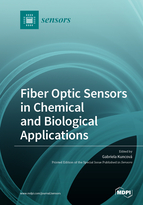Fiber Optic Sensors in Chemical and Biological Applications
A special issue of Sensors (ISSN 1424-8220). This special issue belongs to the section "Optical Sensors".
Deadline for manuscript submissions: closed (15 February 2022) | Viewed by 22577
Special Issue Editor
Interests: optical chemical sensors; whole-cell optical sensors; biodegradation; biocatalysis; organic–inorganic materials; sol–gel science; optical fibers coating
Special Issue Information
Dear Colleagues,
Optical fiber chemical sensors and biosensors have been studied since the production of optical fibers for telecommunications was launched in 1970. Extensive research and development resulted in a wide range of types of sensors with optical fibers. A progress in this field was periodically reviewed in many scientific journals. The advances have accompanied the breakthroughs in nanomaterials, molecular biology, and electronics.
In recent decades, the market of chemical sensors and biosensors has experienced a great development, above all regarding medical healthcare. The subfield of optical fibers sensors has also matured to industrial production of analytical devices such as fluorescence-based oxygen sensors, which have already replaced almost 40% of the commercial market dominated previously by Clark oxygen electrode. The principal causes motivating this situation are increasing population density in combination with frequently repeated water scarcity and flooding. To keep medical care sustainable and to monitor food and water quality will need reliable, low-cost, and easy-to-handle sensors.
At the very beginning, optical fibers served in light transmission from a measured area to a detector. Subsequent research has implemented principles of intrinsic optical fiber sensors. Surface plasmon resonance, evanescent wave, interferometric, and Bragg gratings have become well-established areas of chemical sensors and biosensors. Sensors networks, wireless technology, microreactors, smart phones, robots, drones, and wearable sensors are new challenges for utilization of advantages of all types of optical fiber sensors.
This Special Issue should bring together papers from all parts of optical fiber sensors, especially chemical sensors and biosensors, including:
- Advances in sensor material, properties, fabrication, and novel concepts for fiber-optic chemical and biosensing;
- Novel techniques for medical application in non-invasive measurements in breath and fluids, early detection of disorders, label-free monitoring of physiological state, and wearable sensors;
- Advances in optical fiber sensing for healthcare, environmental application, biotechnology and chemical processes, robotics devices, monitoring of food quality, and pollution in soil and water.
In particular, this Special Issue invites papers focused on demonstrations of existing sensors in real applications.
Dr. Gabriela Kuncová
Guest Editor
Manuscript Submission Information
Manuscripts should be submitted online at www.mdpi.com by registering and logging in to this website. Once you are registered, click here to go to the submission form. Manuscripts can be submitted until the deadline. All submissions that pass pre-check are peer-reviewed. Accepted papers will be published continuously in the journal (as soon as accepted) and will be listed together on the special issue website. Research articles, review articles as well as short communications are invited. For planned papers, a title and short abstract (about 100 words) can be sent to the Editorial Office for announcement on this website.
Submitted manuscripts should not have been published previously, nor be under consideration for publication elsewhere (except conference proceedings papers). All manuscripts are thoroughly refereed through a single-blind peer-review process. A guide for authors and other relevant information for submission of manuscripts is available on the Instructions for Authors page. Sensors is an international peer-reviewed open access semimonthly journal published by MDPI.
Please visit the Instructions for Authors page before submitting a manuscript. The Article Processing Charge (APC) for publication in this open access journal is 2600 CHF (Swiss Francs). Submitted papers should be well formatted and use good English. Authors may use MDPI's English editing service prior to publication or during author revisions.
Keywords
- Optical fiber chemical sensor
- Optical fiber biosensor
- Optical monitoring of chemical processes
- Optical monitoring of biological processes
- Optical monitoring of environmental pollution







